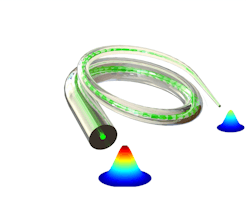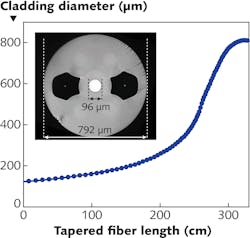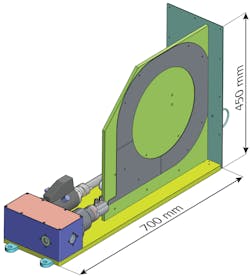Tapered double-clad fiber: The future of ultrafast high-power laser processing
REGINA GUMENYUK and VALERY FILIPPOV
Ultrafast lasers with pulse durations in the femtosecond and picosecond range currently play an important role in many industrial processes. The value of these lasers for high-quality, virtually athermal materials processing, coupled with advances in laser technology, process development, beam handling, and delivery, have opened the door for numerous advanced scientific and industrial applications.
Recent developments using tapered double-clad fiber (T-DCF) amplifiers now offer the prospect of high power with excellent beam properties in a space-effective format and, most remarkably, at production costs little more than normal fibers. This means the increasingly important cost per watt of these ultrafast lasers may be ideally positioned for rapid industrial uptake by delivering rapid investment returns from increased processing speed and precision.
The dramatic rise in output power from rare-earth-doped fiber sources over the past decade, via the use of cladding-pumped fiber architectures such as the NKT Photonics aeroGAIN-ROD,1 has led to a range of fiber-based devices with exceptional performance in terms of beam quality, overall efficiency, and flexibility in operating wavelength and radiation format, with power handling previously only available in solid-state configurations. While significant advances in solid-state high-power ultrafast technologies are also being made using new configurations like the Amphos InnoSlab technology, the high cost of solid-state gain material and thermal management challenges may still present significant barriers to its widespread adoption.
The European Commission (EC) funded the PULSE project (www.pulse-laser.eu) to support the development of competitive technologies that enable faster, more precise, and nonthermal laser manufacturing. Ampliconyx Oy and the consortium of European partners including Fiat Chrysler are now developing a T-DCF laser to deliver up to 2.5 kW with pulse durations as short as 100 fs and repetition rates up to 1 GHz. The complete laser processing system will handle high-power ultrashort pulses with scanning speeds up to 1.5 km/s using polygon-scanner technology and fiber integrated optics to provide spot sizes down to 10 µm.
The rise of high-power ultrafast fiber lasers
Ultrafast pulsed lasers have seen exponential growth, with the number of filed patents increasing fivefold from about 100 to 500 per year. Several advanced niche applications have benefited from femtosecond laser processing, including in photonics, microelectronics, MEMS, and many other markets.
Fiber, solid-state, and disk lasers are the most promising candidates for high-average-power generation. The outstanding characteristics of fiber lasers compared to solid-state and disk lasers include compactness, robustness, efficiency, ease of thermal management, and reliable beam quality. Significantly lower production and maintenance costs also make fiber-based approaches highly appealing for pico- and femtosecond high-repetition-rate kilowatt-level laser development.
Today’s high-average-power fiber lasers generally use chirped-pulse amplification (CPA). However, in boost fiber-based amplifiers, even for highly stretched pulses the optical peak intensities can become very high, producing detrimental nonlinear pulse distortion or even destruction of the gain medium or other optical elements. Additionally, other nonlinear effects such as self-phase modulation, stimulated Raman scattering (SRS), mode instabilities, and poor output beam quality often arise in pulsed high-power systems limiting their performance.
The main approach to solving problems for pulsed signal amplification has been to enlarge the core diameter of the fiber. Special active fibers with large mode area were developed to increase the surface-to-active-volume ratio of active fibers and, hence, improve heat dissipation and elevate the threshold of nonlinear effects enabling power scaling. State-of-the-art high-power fiber-based technologies have already approached >1 kW in a single pulsed amplification channel2 and laid a cornerstone for future ultrashort multikilowatt-level fiber-based laser systems.
Several types of active fibers with a large effective mode area (LMA) have been developed for high power scaling. They are well-known LMA fibers with a low-aperture core, microstructured rod-type fiber, helical-core or chirally coupled core fibers, and T-DCFs. The mode-field diameter (MFD) achieved with these low-aperture technologies usually does not exceed 20–30 μm. The microstructured rod-type fiber has a much larger MFD of up to 65 μm and good performance. Recently, an impressive 2.2 mJ pulse energy was demonstrated by a femtosecond master oscillator power amplifier (MOPA) containing large pitch fiber (LPF).3 However, LPF fabrication is highly complex, requiring significant processing such as precision drilling of the fiber preforms, leading to higher production costs. These fibers are also highly sensitive to bending, meaning that achieving adequate robustness can be challenging and that reasonable production costs are difficult to envision using LPF.
Overcoming nonlinear effects in fiber-laser power scaling
T-DCF is one of the promising alternatives for high-power fiber-based CPA systems, minimizing nonlinear effects while simultaneously simplifying the normal multicascade amplification chain by replacing it with a single stage (see Fig. 1). The T-DCF is a double-clad optical fiber formed using a specialized fiber drawing process in which temperature and pulling forces are controlled to form a taper along the length of the fiber. By using pre-clad fiber preforms, both the fiber core and the inner and outer cladding layers vary in diameter and thickness along the full length of the fiber. This tapering of the fiber forms a continuous chain of amplifiers with ever-growing core diameter and enables the combination of the features of conventional 8–10 µm diameter double-clad single-mode fibers with those of much larger diameter (50–100 µm) double-clad multimode fibers used for high-power amplification (see Fig. 2).The result of forming a tapered geometry double-clad fiber is that the light introduced into the thin end propagates in a wide core without changing the mode content. It is well known that sequentially increasing the diameter of multiple series of cylindrical optical fiber amplifiers generally increases the threshold of unwanted nonlinear effects. The T-DCF design incorporates this benefit in single fiber; as a result, optical amplification maintains excellent beam quality by raising the stimulation thresholds of nonlinear effects, including Brillouin and Raman scattering.
Due to its specific geometry, the T-DCF technology can be used for direct amplification of wide range of the pulsed signals: from the short (several tens of picoseconds) to long (up to hundreds of nanoseconds) and from narrow (a few tens of picometers) to broad linewidths (a few tens of nanometers). Using tapered fiber with large end core diameters of up to 200 µm with a 0.11 numerical aperture (NA), record peak power and energy amplification levels and 60 ps pulses with 300 µJ energy free of nonlinear distortions have been reported.4
The fiber’s double-clad structure means that its core can be pumped with higher power than could be propagated only in the core. The absorption and conversion of pump light per unit length is higher in the tapered fiber compared to cylindrical fibers with similar levels of active ion doping. This is due to the improved clad mode mixing and the higher absorption at the thicker end of the taper due to the much thicker cladding. This also means that the rare-earth ion dopants are usefully concentrated at the wide end of a T-DCF, since the geometry defines their presence as directly proportional to the square of the diameter.
Simplicity of production and compactness of assembly
One of the most significant advantages of T-DCF is the simplicity of production. The preform production for special high-power fibers (microstructured rod-type fibers, 3C, or LCFs) involves complex technology and strict structural requirements. In contrast, T-DCF is made using standard fiber preforms. Simple production techniques varying the drawing speed during the pulling process lead to the fiber diameter changing along its length. T-DCF production is almost as simple as the production of a regular active fiber. T-DCF fiber can be coiled with a diameter as small as 35 cm, making a high-power amplifier package very compact without degradation of the performance (see Fig. 3).The future of ultrafast high-power laser processing
The complete laser processing system exploiting all advantages of the T-DCF technology in combination with novel beam shaping components, advanced delivery fiber, and polygon scanner can overcome the relatively long processing times that are a major shortcoming to the industrial implementation of laser-machining solutions today. These developments from the PULSE consortium will be of special interest to the automotive sector aiming to reduce vehicle weight and accelerate injection-mold texturing or battery production processes for new electric vehicles.
ACKNOWLEDGMENT
The PULSE project, members of which contributed to this article, is an initiative of the Photonics Public Private Partnership, www.photonics21.org. This project has received funding from the European Union’s Horizon 2020 research and innovation program under grant agreement No 824996.
REFERENCES
1. See https://bit.ly/PULSERef1.
2. M. Müller et al., Opt. Lett., 41, 3439–3442 (2016) and M. Müller et al., Opt. Lett., 43, 6037–6040 (2018).
3. T. Eidam et al., Opt. Express, 19, 1, 255–260 (2011).
4. V. Filippov, Y. K. Chamorovskii, K. M. Golant, A. Vorotynskii, and O. G. Okhotnikov, Proc. SPIE, 9728, 97280V (Mar. 11, 2016); doi:10.1117/12.2218051.
Regina Gumenyuk is Senior Research Fellow at Tampere University and Valery Filippov is CTO at Ampliconyx Oy, both in Tampere, Finland; e-mail: [email protected]; www.tuni.fi/en.


